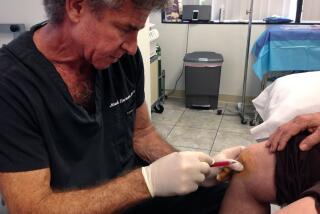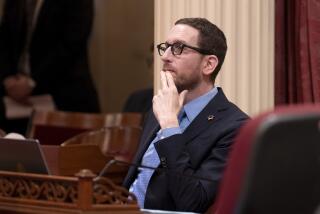Missed opportunities at California stem cell research agency
For a state agency that aims to define the term “visionary,” the California Institute for Regenerative Medicine — the stem cell bureau, as it were — has always displayed a curious lack of vision about its own responsibilities.
The taxpayer-funded institute was created by Proposition 71 in 2004 to find cures for diabetes, AIDS, Alzheimer’s and a host of other conditions via stem cell research, using $3 billion in bond proceeds ($6 billion including interest).
It goes without saying that it hasn’t found those cures, though not for want of spending. Nor has it managed to temper public expectations pumped up by the original initiative campaign, or resolved the persistent questions about whether its grant-making process is subject to adequate public oversight or free of conflicts of interest.
Having sat in on part of the agency board’s selection process for a new chairman, I can tell you it hasn’t made much of an advance at solving its chronic management difficulties either. The chairmanship search has been a mess, and that couldn’t happen at a worse time.
The agency is contemplating how to replenish its funds — possibly by going back to voters for a new bond issue — while pressure increases for it to show concrete progress toward disease cures.
“We’re at a critical crossroads,” State Controller John Chiang, the only state official with direct oversight of the agency (and precious little, at that), told me recently. “The voters invested a significant amount of money for what they thought was going to be life-changing improvement….[CIRM] hasn’t produced a game-changer in the public mind-set.”
Proposition 71’s resounding victory at the polls followed an ad campaign featuring inflated optimism about stem cell science and spearheaded by Robert Klein, a Northern California real estate man who wrote the initiative.
His authorship may explain why the measure set down qualifications for the board chairman that fit himself to a T, while shielding the agency from almost any oversight by elected state officials. Guess who got the job?
Klein announced last year that he was stepping down, and promptly got tangled in accusations that he was trying to handpick his successor behind closed doors, though Proposition 71 dictates that it’s up to the governor, lieutenant governor, treasurer and controller to submit nominees from whom the board must choose.
Klein’s choice was Alan Bernstein, a prominent Canadian research administrator who had chaired a panel of outside experts hired to produce a purportedly independent appraisal of the stem cell agency’s work. The panel’s report, issued last year, was glowing. Klein and the agency finessed the consequent brouhaha by suddenly discovering that state law forbids the appointment of a non-American citizen, though some legal experts contended that no such obstacle exists. (I’m indebted to David Jensen of the California Stem Cell Report for pulling together the facts on the case.)
The new round yielded two candidates. One is Jonathan Thomas, 56, a Los Angeles investment banker with university degrees in biology and history and experience in the biotech investment field. He’s the nominee of Gov. Jerry Brown, Lt. Gov. Gavin Newsom and Treasurer Bill Lockyer. Chiang’s candidate is Frank Litvack, 55, a former cardiology professor at Cedars- Sinai and executive and investor in medical technology companies.
They’re estimable candidates, either of whom would bring useful qualities to the job. Among other things, they’re committed to advancing stem cell science and they understand that making a compelling public case for the agency’s research is of paramount importance.
Yet that doesn’t obscure the fact that the entire search process has been a missed opportunity. This time of managerial transition would have been the perfect moment for the board to ponder the broader issues swirling around the institute.
Over the years, the agency has been criticized for being too narrowly focused on a particular field of scientific research and overly secretive. The Little Hoover Commission concluded in 2009 that the 29-member board was too large to be efficient and too lacking in independent voices — no surprise, since Proposition 71 requires that almost every member represent some group or entity with an interest in stem cell funding.
But those issues aren’t on the table in the board’s discussions with the two candidates. Both told me in separate interviews that they thought the board members were more or less outstanding and, anyway, them’s the rules.
I have no grounds for suspecting that the candidates are simply playing up to the people who will be deciding whether to hire them, but it’s sadly typical of the agency’s governing board that such crucial issues of governance are ignored. Instead, the discussion seems to revolve more around whether the candidates think the chairmanship is a full-time hands-on job or a part-time oversight job and where in the board’s stated salary range of about $150,000 to $400,000 they’d place themselves. (Litvack thinks it’s an oversight job and would be happy at the low end of the salary scale; Thomas that it’s a full-time job and implicitly warrants a higher figure.)
The institute’s most glaring inadequacy as a state agency is its lack of integration with the state’s overall research investment. That shortcoming has never been addressed by the board except to give the cold shoulder to critics who raise the issue.
Indeed, given the current research and budgetary environment, the institute probably shouldn’t exist. Its impetus came from the Bush administration’s strictures on research involving embryonic stem cells, but those impediments evaporated after the change of administrations in Washington. (A federal judge’s effort last year to revive the restrictions has been reversed on appeal.)
There’s no question that stem cell research is important and potentially groundbreaking. But with every budget year, the folly of generously funding research in one research field while everything else withers away grows more obvious, nowhere more so than in the state’s treatment of the University of California. Plenty of the stem cell money goes to UC campuses, but plenty does not. The largest single recipient? Stanford, a private university, which has received more than $192 million of taxpayer money as of May 4. That’s more than UCLA and UC Berkeley combined.
Brown’s proposed budget in January cut state support to UC by $500 million (along with $900 million in cuts to community colleges and Cal State.) UC has responded to years of budget cuts by shrinking science course offerings, so that it takes some students five or even six years to acquire all their required credits to graduate.
UC has also increased the slots offered to out-of-state applicants, who pay higher tuition than state residents, raising their share of admissions to 18% from 11.6% just two years ago. That’s as many as 4,700 more slots offered to non-California students than would have been offered in 2009, based on the percentages. Of the 4,700 California students turned away from some of the nation’s premier research institutions, how many might have made their own contributions to scientific revolutions bringing wealth and glory to the state of California? We’ll never know.
Isn’t this a legitimate issue to be addressed by the stem cell institute’s board and its candidates for chair? Think of it this way: What does California gain if the institute gleams the more brightly because it’s the only diamond left in a research landscape it helped turn into a desert?
Michael Hiltzik’s column appears Sundays and Wednesdays. Reach him at mhiltzik@latimes.com, read past columns at latimes.com/hiltzik, check out facebook.com/hiltzik and follow@latimeshiltzik on Twitter.
More to Read
Inside the business of entertainment
The Wide Shot brings you news, analysis and insights on everything from streaming wars to production — and what it all means for the future.
You may occasionally receive promotional content from the Los Angeles Times.











